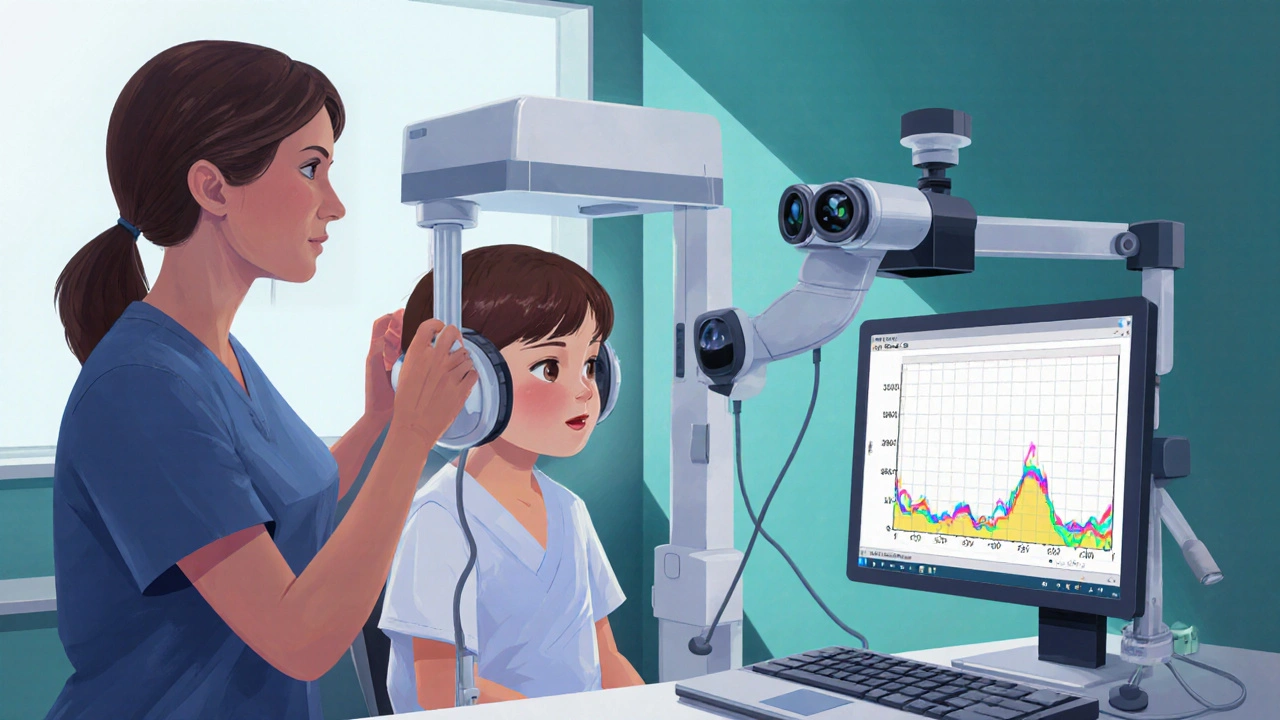Meniere's Disease in Children: Symptoms, Diagnosis & Treatment Guide

When a child repeatedly feels like the room is spinning, hears ringing, or suddenly loses hearing, parents often feel helpless. Meniere's disease is a chronic inner‑ear disorder that causes episodes of vertigo, fluctuating hearing loss, tinnitus and a feeling of fullness in the ear. Though it’s most recognized in adults, the condition can surface in kids as young as five. Understanding the tell‑tale signs, how doctors confirm the diagnosis, and what treatment paths exist can turn a confusing nightmare into a manageable routine.
Key Takeaways
- Vertigo, hearing loss, tinnitus, and ear fullness are the four classic symptoms; at least two recurring episodes raise suspicion.
- Diagnosis relies on a mix of detailed history, audiometry, vestibular testing, and sometimes MRI to rule out other causes.
- Treatment starts with lifestyle tweaks-low‑sodium diet and stress management-before moving to medication, intratympanic injections, or surgical options.
- Early involvement of a pediatric otolaryngologist improves long‑term hearing preservation.
- Family support, vestibular rehab, and regular monitoring are essential for quality of life.
What Does Meniere's Disease Look Like in Kids?
The classic adult picture-spinning attacks lasting 20 minutes to several hours-often appears in children but with a few twists:
- Vertigo is the sudden sensation that the room is moving. In children it may be described as “the world is turning” or simply expressed through crying and clinging.
- Fluctuating hearing loss can be mild at first, often affecting the low frequencies. Parents may notice the child asking for the TV volume to be higher.
- Tinnitus-a ringing or buzzing sound-may be hard for a young child to articulate, but they may cover their ears or claim “I hear a buzzing.”
- A sense of fullness or pressure in the ear, sometimes described as “my ear feels heavy.”
Because children may not label these experiences accurately, clinicians look for patterns: multiple episodes over weeks or months, each lasting more than a few minutes, and at least two of the four symptoms occurring together.
How Doctors Pin Down the Diagnosis
There’s no single lab test that says “Meniere's.” Diagnosis is a process of exclusion and confirmation.
- Detailed medical history: Doctors ask about the frequency, duration, and triggers of episodes. They also check for family history-some families carry a genetic predisposition.
- Audiometry (hearing test): Using age‑appropriate equipment, an audiologist measures the child’s hearing thresholds across frequencies. A classic finding is a low‑frequency dip that may improve between attacks.
- Vestibular testing: The videonystagmography (VNG) or electronystagmography records eye movements while the child’s balance system is stimulated. Abnormal results support inner‑ear involvement.
- Imaging: While an MRI rarely shows Meniere's itself, it rules out tumors, cysts, or abnormal blood vessels that could mimic symptoms.
- Endolymphatic hydrops assessment: In research centers, contrast‑enhanced MRI can visualize the fluid build‑up (hydrops) behind the inner ear. It’s not routine but adds certainty when available.
If the child meets the American Academy of Otolaryngology‑Head and Neck Surgery (AAO‑HNS) criteria-two or more definitive episodes plus audiometric evidence-the diagnosis is solid.

First‑Line Treatment: Lifestyle Tweaks
Before diving into drugs, doctors often recommend three low‑effort changes that can shrink attack frequency.
- Low‑sodium diet: Reducing daily salt intake to under 1,500mg helps regulate inner‑ear fluid pressure. Simple swaps-fresh fruit instead of processed snacks, seasoning with herbs instead of salt-make a big difference.
- Hydration balance: Encourage steady fluid intake throughout the day, avoiding large caffeine‑rich sodas that can affect fluid dynamics.
- Stress management: Stress is a known trigger. Techniques such as guided breathing, short yoga sessions, or even a short daily walk can calm the vestibular system.
Parents often find a nutritionist helpful to create kid‑friendly low‑sodium meals without sacrificing taste.
Medication Options When Lifestyle Isn’t Enough
If episodes persist, the next step is medication. The goal is to control vertigo, reduce nausea, and protect hearing.
| Medication | Purpose | Typical Pediatric Dose | Key Side Effects |
|---|---|---|---|
| Betahistine | Improves inner‑ear blood flow, reduces vertigo frequency | 16‑48mg three times daily (weight‑based) | Headache, nausea |
| Acetazolamide | Decreases fluid production in the inner ear | 5‑10mg/kg/day divided twice | Kidney stones, tingling |
| Intravenous corticosteroids | Reduces inflammation during acute attacks | Methylprednisolone 0.5mg/kg IV daily for 3‑5 days | Weight gain, mood swings |
| Diuretics (e.g., hydrochlorothiazide) | Promotes fluid drainage from the inner ear | 1‑2mg/kg once daily | Electrolyte imbalance |
Medication choice depends on attack severity, side‑effect tolerance, and the child’s overall health. A pediatric ENT or neurologist tailors the regimen.
Procedural Interventions for Refractory Cases
When attacks continue despite diet and meds, doctors consider two main procedures.
- Intratympanic gentamicin injection: A tiny dose of the antibiotic is placed directly onto the eardrum, targeting the vestibular hair cells that cause vertigo. It often eliminates vertigo but carries a risk of permanent hearing loss-so it’s reserved for kids who can tolerate that trade‑off.
- Surgical shunt or endolymphatic sac decompression: These operations create a drainage pathway for excess fluid, aiming to preserve hearing while reducing vertigo. Success rates vary, and recovery involves weeks of vestibular rehab.
Both interventions are performed by a skilled pediatric otolaryngologist and require close follow‑up.

Living with Meniere's: Everyday Strategies
Even with optimal treatment, children may have occasional episodes. Here are practical tips families use:
- Keep a symptom diary: Note date, duration, foods eaten, stressors, and what helped. Over time patterns emerge.
- Equip the school: Provide the teacher with an emergency plan-allow a quiet space, extra time for tests, and permission to sit down during an attack.
- Use hearing aids or FM systems if permanent hearing loss develops. Modern devices are discreet and can be synced to classroom audio.
- Practice vestibular rehabilitation exercises at home: Simple head‑turning and balance tasks improve the brain’s compensation ability.
- Stay connected with support groups-online forums for families dealing with pediatric vestibular disorders provide emotional backup and practical hacks.
When to Seek Immediate Care
Most episodes resolve on their own, but certain red flags demand urgent attention:
- Sudden, profound hearing loss in one ear.
- Vertigo lasting more than 24hours.
- Associated neurologic signs: double vision, facial weakness, or severe headache.
- Signs of infection-fever, ear drainage, or intense ear pain.
Prompt evaluation can prevent complications and rule out conditions like labyrinthitis or acoustic neuroma.
Frequently Asked Questions
Can Meniere's disease cure itself in children?
Spontaneous remission is rare. Most children experience a fluctuating course that stabilizes with treatment. Ongoing management is usually needed.
Is a low‑sodium diet really that important?
Yes. Reducing salt helps lower inner‑ear fluid pressure, which directly cuts down the frequency and intensity of vertigo attacks. Most studies show a 30‑40% reduction in episodes with strict sodium restriction.
Are hearing aids safe for kids with Meniere's?
Absolutely. Modern behind‑the‑ear or receiver‑in‑canal devices are lightweight and can be fitted to accommodate fluctuating hearing levels. Regular audiology check‑ups ensure optimal settings.
What is the success rate of intratympanic gentamicin?
About 80‑90% of treated children report complete resolution of vertigo, but permanent hearing loss occurs in roughly 10‑15% of cases. Doctors weigh this risk against the disability caused by uncontrolled attacks.
Can stress really trigger an attack?
Stress amplifies the autonomic nervous system, which can affect inner‑ear fluid balance. Many families notice attacks after exams, sports competitions, or family arguments, so stress‑reduction strategies are a core part of therapy.

Zach Yeager
October 12, 2025 AT 01:36Kids get vertigo you can't just brush off it's a real medical issue and we need to stop pretending it's just 'grown‑up stuff'
Angel Gallegos
October 12, 2025 AT 09:56While the article covers the fundamentals, it suffers from a lack of depth and several grammatical oversights. The prose feels overly simplistic, and terms like “vertigoe” appear where “vertigo” would be correct. Additionally, the section on dietary changes could benefit from citing specific sodium thresholds rather than vague recommendations. A more rigorous approach would elevate the piece from a casual overview to a credible resource.
ANTHONY COOK
October 12, 2025 AT 18:16Your point is valid but the real problem is how the healthcare system ignores early detection 🙄 without systematic screening many kids slip through the cracks and suffer longer than necessary.
Sarah Aderholdt
October 13, 2025 AT 02:36Early recognition can spare families endless anxiety.
Phoebe Chico
October 13, 2025 AT 10:56Imagine a tiny storm inside the ear, swirling like confetti at a parade, that's what these kids endure. The relentless spin can feel like the world is on a carousel that won't stop, and the ringing becomes a constant soundtrack to their day. When that pressure builds, it's as if someone placed a heavy weight on the side of their head, making concentration a monumental task. Yet, with the right diet and stress‑relief tools, that tempest can be calmed, allowing the child to reclaim quiet moments.
Larry Douglas
October 13, 2025 AT 19:16It is incumbent upon the practitioner to recognize that the pathophysiology of pediatric Menière's disease diverges in several respects from its adult counterpart, thereby necessitating a nuanced diagnostic algorithm. The initial clinical encounter should prioritize a comprehensive otologic history, delineating the frequency, duration, and phenomenology of vertiginous episodes. Audiometric evaluation must be age‑appropriate, employing conditioned play audiometry for younger patients to obtain reliable threshold data. Vestibular assessment, such as video head impulse testing, provides objective corroboration of peripheral involvement. Imaging, while rarely diagnostic of hydrops itself, serves as a critical exclusionary tool for neoplastic or vascular etiologies. Dietary modification, particularly sodium restriction to under 1500 mg per day, has been demonstrated in longitudinal studies to reduce attack frequency by approximately thirty percent. Pharmacologic interventions should be titrated according to symptom burden, with betahistine and diuretics constituting first‑line agents; however, the pediatric dosage must be calibrated to weight. In refractory cases, intratympanic gentamicin offers vertigo control at the expense of a quantifiable risk of sensorineural hearing loss, a trade‑off that must be discussed thoroughly with caregivers. Surgical options, including endolymphatic sac decompression, remain reserved for the minority of patients who fail medical management despite adherence to lifestyle recommendations. Vestibular rehabilitation therapy, encompassing habituation and substitution exercises, facilitates central compensation and improves functional balance. Moreover, psychosocial support for both the child and family mitigates the emotional sequelae that accompany chronic vestibular dysfunction. Regular follow‑up appointments are essential to monitor auditory status and to adjust therapeutic regimens in response to disease progression. Lastly, participation in support groups can provide invaluable peer‑to‑peer insight, fostering resilience in affected families.
Michael Stevens
October 14, 2025 AT 03:36Hang in there, you're doing the right thing.
Ann Campanella
October 14, 2025 AT 11:56Honestly the article glosses over the emotional toll on parents and that is unacceptable.
Desiree Tan
October 14, 2025 AT 20:16Push forward with that low‑sodium plan, it will cut those attacks down or you'll see no progress.
Andrea Dunn
October 15, 2025 AT 04:36If you think the meds are safe forget the hidden agenda behind pharma they don't want you to know 😉
Erin Johnson
October 15, 2025 AT 12:56Oh great, another miracle cure that promises to fix everything while ignoring the fact that we’ve been dealing with this for decades.
Rica J
October 15, 2025 AT 21:16Actually the term is 'vertigo' not 'vertigoe' and you might want to double‑check the spelling of 'hydrops' - just a friendly heads‑up.
Linda Stephenson
October 16, 2025 AT 05:36I find it fascinating how stress can literally shift fluid balance in the inner ear, showing the mind‑body connection.
Sunthar Sinnathamby
October 16, 2025 AT 13:56Get that symptom diary going now and watch patterns emerge, you’ll be surprised how much control you can reclaim!